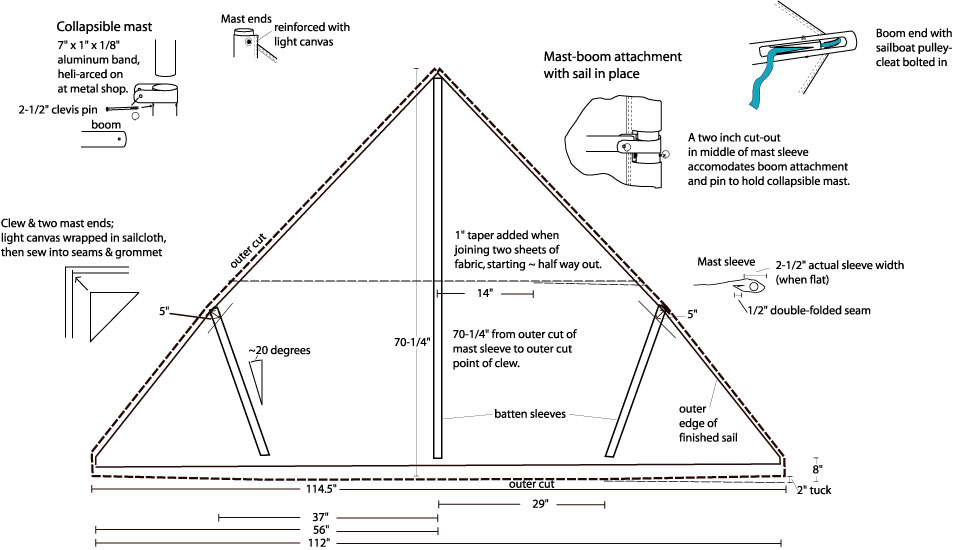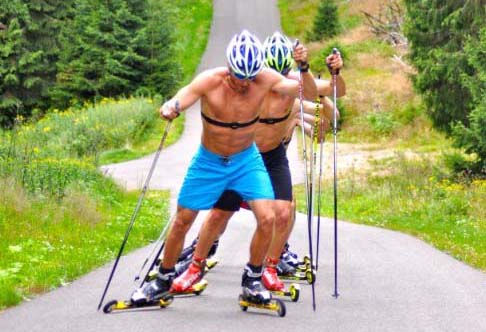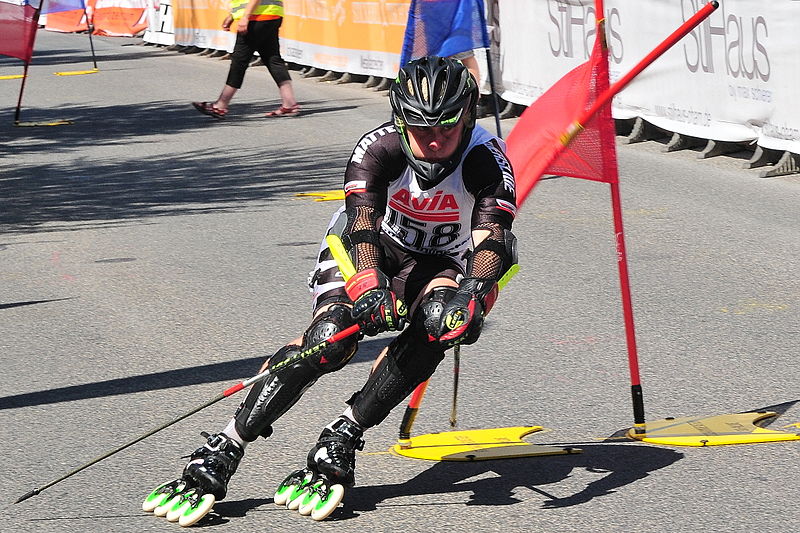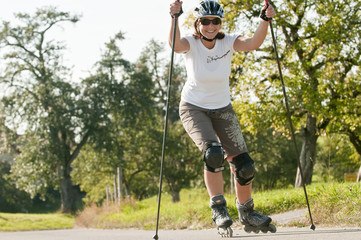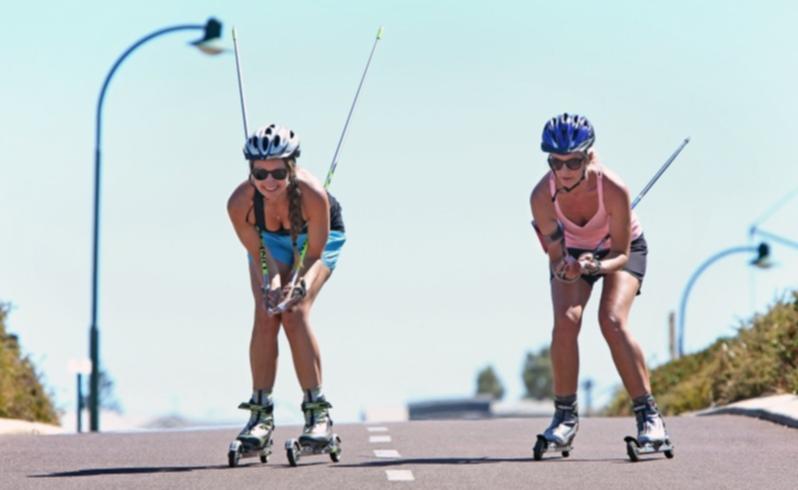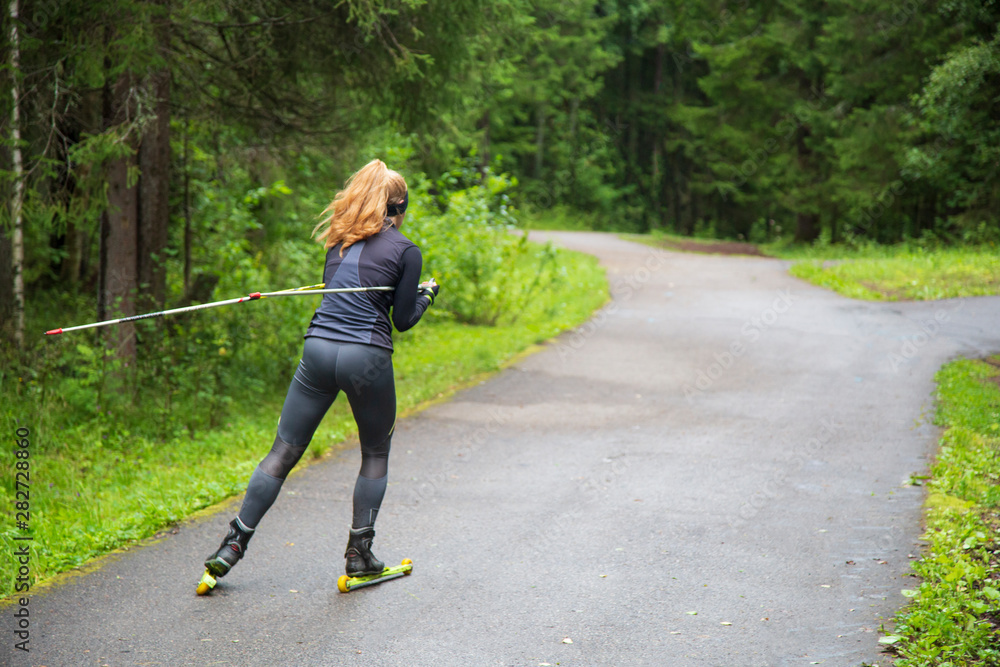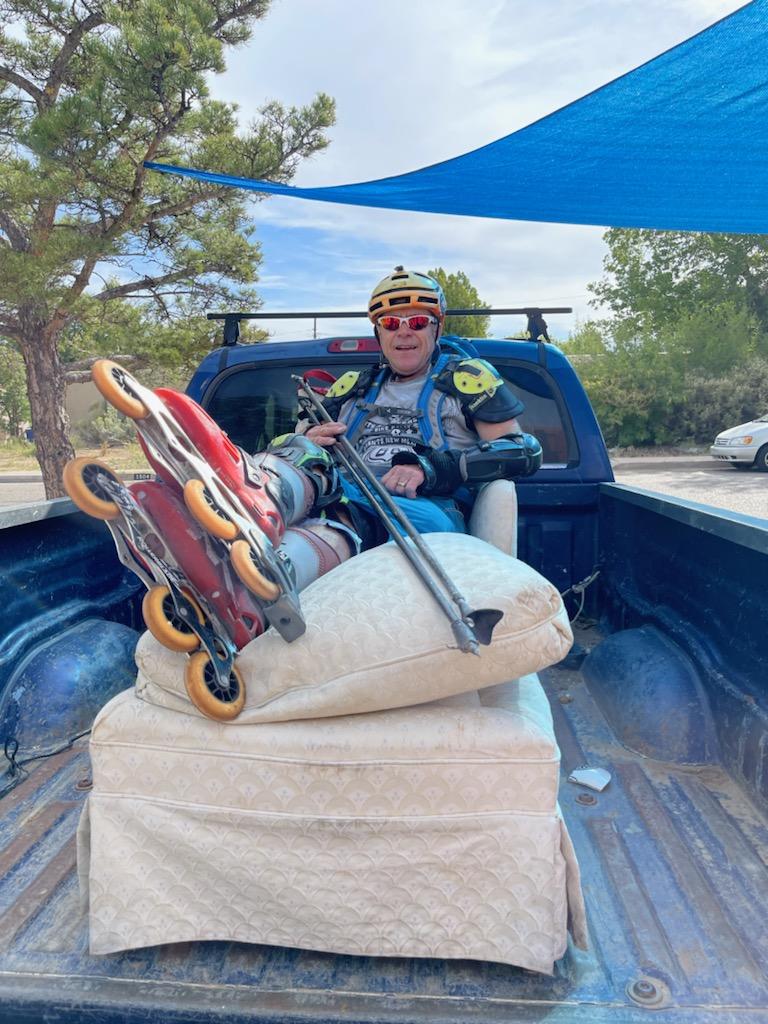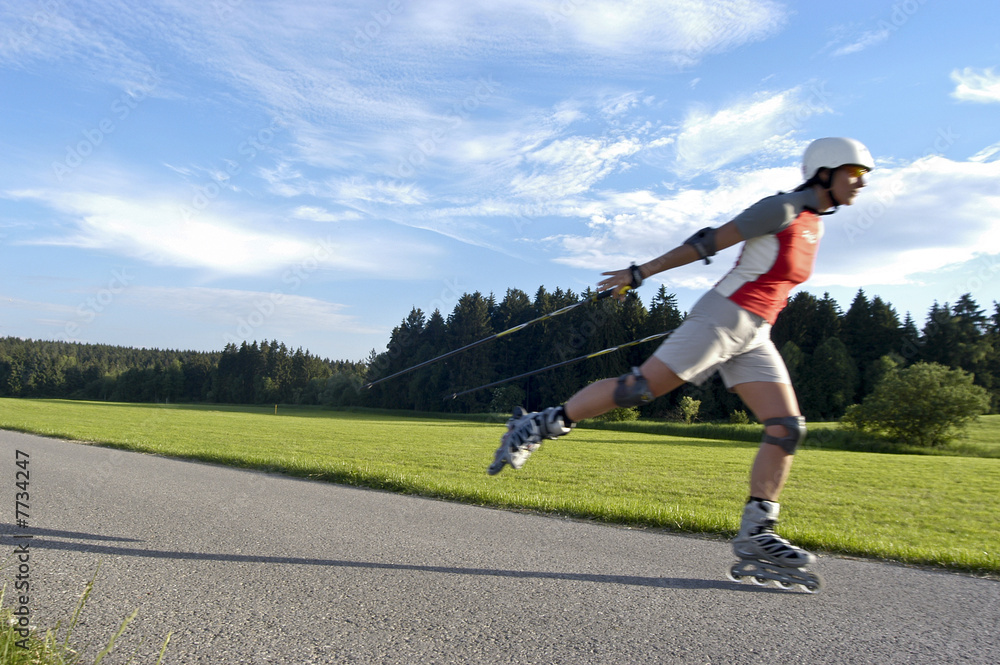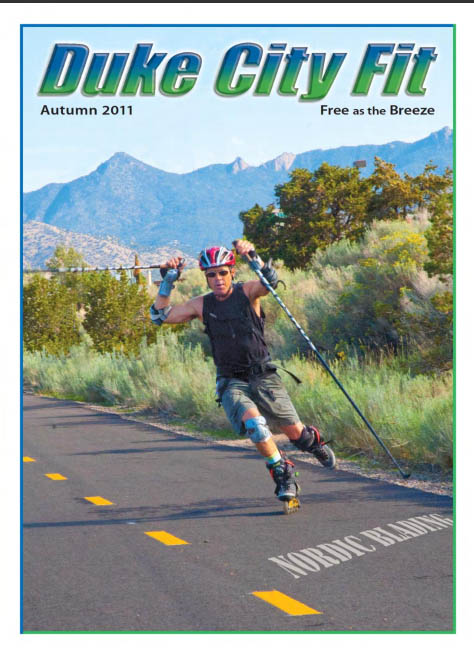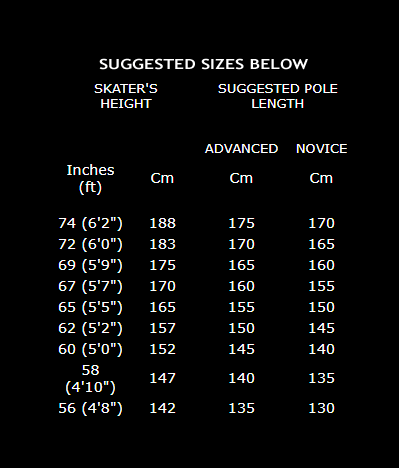Hand held poles have traditionally been used for balance and propulsion in snow sports. The use of poles for other sports, mainly hiking, has increased.
Another, less common use of poles is for ‘roller skiing’ on pavement, either with specialized wheeled skis or inline skates. This primarily attracts small cadres of cross-country skiers for dryland training.
The benefit is an exhilarating workout which incorporates cardiovascular, stretching, and high repetition, low stress muscle movement.
Rollerblade Ski Poles
Rollerski Poles work well for pushing on pavement. DON’T STICK YOUR POLES IN CRACKS; it can break your tip off and rip your shoulder. I have learned to pull up quickly when a pole tip accidentally goes in a crack.
The tips usually need about a ’10mm’ diameter on the end of the pole where the tip goes. This is usually found on a ski touring or racing pole which taper down, vs just a continuous width. So you may need to shop around some on line or retail shops. Nordic Skater is one outlet which sells roller ski poles.
As far as length. mine are nose-high on skates. much below shoulder level you lose the physics of a long push.
Two key things to double your speed: Get really long poles, and keep your tips sharp. I use a diamond blade to sharpen them every few times.
Otherwise you’ll just be muddling along while your poles slip and you throw your shoulders out of joint.
Basic stroke is what you would think; right foot push combined with a left pole push, then vice versa, alternating. Your goal should be a long pole push starting beside your foot and extending back 4-5 feet.
Or if you are in or near Albuquerque I can sell you some premium poles as pictured here–delivery or pickup.
Lessons
On a gentle Albuquerque bikepath: $50 for an hour and a half lesson, $75 for two people. Equipment, Basic and Advanced Strokes for full body workout, avoiding falls, optimizing your workout. You provide the blades/skis and protective equipment and I supply the roller ski poles. Hip protection is good and I can hook you up with hockey pants. Call 505-440-1219
Workouts
With a dozen or so stroke combinations, you can target most muscle groups and your core. For example, progressing from the basic stroke alternating foot pushes and pole strokes on opposite sides, you can move to double pole, bending at the waist. which builds abs, pects, delts, triceps and biceps, and the long muscles of the abdomen and back.
Safety
Number one is don’t put your pole down in front of your skates-or do it once because then you’ll never do it again. As with all skating, knee elbow wrist protection and a helmet. Padded pants such as those used for hockey are good too. I wear two pair of hockey training pants for hip and lower back protection. Cars are the major problem so stick to bikepaths or empty roads.
Fun
Besides the all-around aerobic workout, the sport can be a rush and a real benefit for alpine ski training. I plan my routes to start with an uphill or upwind leg, so the return trip includes some exhilirating carving. IT DELIVERS SKATE-SKI WORKOUT BUT MUCH MORE DYNAMIC AND VARIABLE.
Go for the smoothest roads or trails–because of such a low-friction environment–your every efficiency is rewarded threefold compared to being on snow.
Urban Exploration
If you want to explore a city or landscape at street level, nothing could be better than Rollerpoles. The Ability to hop up curbs, climb stairs, or climb over a fence gives you an incredible mobility that exceeds bikes, and a speed which exceeds going on foot.
Equipment
I would recommend rollerblades or inline skates with at least 82mm wheels. 10″ – 12″ wheelbase recommended for 4-wheel skates. Not sure how this shakes out with 3 wheel skates, but you want a wide arcing turn for Giant Slalom and for motivated skate-ski workout, otherwise it’s hard to get a good momentum and you’ll top out at 4-5 mph on the flats and your carving will be like little short tiny skis. I have migrated to 90mm, then 100mm wheels. Rotate your wheels every 30 miles or so or when the insides of the wheels (especially front and back) get visibly worn. Older worn wheels take away from the smooth turns and easy riding. Roller ski tips should be sharpened every few times. You want it to have a bite when you touch it like it could cut your skin. Again, hockey pants like from Play it Again Sports can help prevent hip fracture.
[WHEEL ROTATION – SWITCH SIDES AND MOVE WHEELS ONE SPACE FORWARD AND FRONT WHEEL TO BACK. IF YOU GET MIXED UP, JUST MAKE SURE LESS-WORN SIDE IS TOWARD THE MIDDLE]
TIPS TO PREVENT FALLING!

DON’T STICK YOUR POLE IN FRONT OF YOUR SKATE
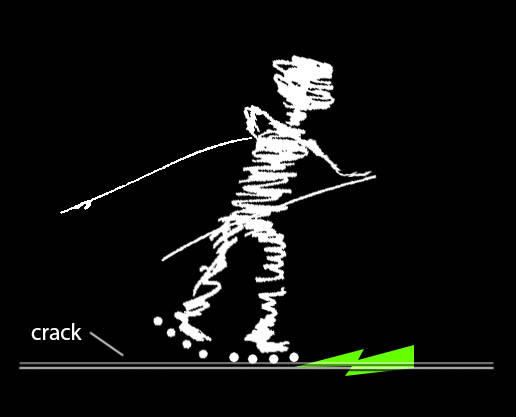
LONGITUDINAL CRACKS WILL GRAB YOUR WHEELS
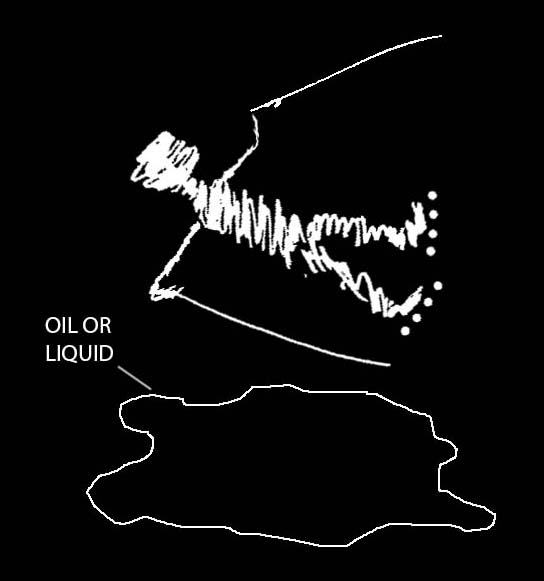
SPILLED OIL OR LIQUIDS WILL SLIP YOU UP
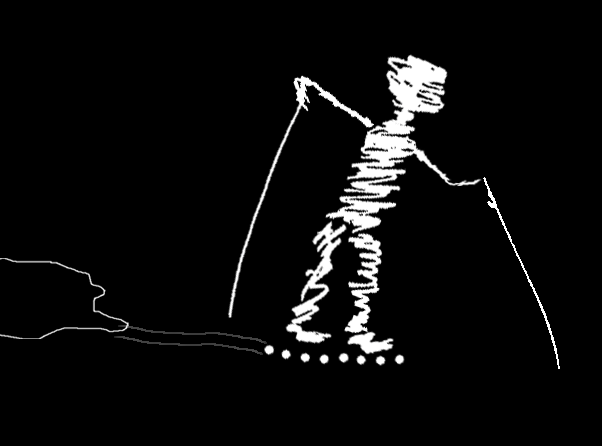
LET YOUR WHEELS DRY AFTER GOING THROUGH A PUDDLE
If you’re ready for some real fun, here are plans for a Skate Sail for inline-skates or skateboards. Made with nylon fabric and swimming pool tubes. It is similar to a sailboard sail, but it is detached and much lighter. It is symmetrical, so you can flip it over to turn around. Usable in winds 20mph+.
This evolved from garbage bags to sewn nylon in the 70’s to sail the deserted streets of the growing West Mesa. These days a similar thing is called ‘Wing Foil’ and would probably work great.
And if you have to bail, just drop the thing, which is exactly what I’ve been doing since I was 17 when I sewed the first one.
